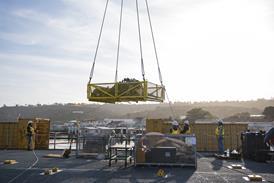Julian Moxon/PARIS

Flight tests of the Thomson-CSF Optronique front sector optronics (FSO)system that will give the Dassault Rafale fighter a passive infrared and television imaging capability have begun on a Dassault Falcon 20 testbed.
The FSO will provide all-weather air-to-air and air-to-ground surveillance and targeting and, says Thomson-CSF Optronique, is the first such system in the West to work on the 3-5 micron band as well as the usual 8-12 micron wavelength, the former providing "considerably improved detection in humid conditions".
Only the TV component of the FSO has been tested so far. "We're expecting to begin tests on the infrared system in the next few weeks," says Thomson-CSF Optronique commercial director Jean-Claude Vergnères.
The unit will be integrated with the radar after completion of laboratory testing and delivery of the complete infrared system by FSOco-developer Sagem.
The optronics will be slaved to the Rafale's Spectra self-defence system, the RBE2 multirole radar, or the missile infrared seeker. Operational deployment is scheduled for 2003 on the F2 version of the Rafale, which will have air-to-air and limited air-to-ground capability.
Thomson-CSF Optronique says exact performance details of the FSO are classified, but it is understood that, at 20,000ft (6,100m), for example, in air-to-air mode, the system will have an infrared detection capability of about 70nm (130km), or 60nm at low altitude, while laser ranging will be possible to 12nm.
Thomson-CSF Optronique is also developing the Damoclese 3-5 micron infrared air-to-ground attack and "pseudo-recognition" pod for the Rafale and Mirage 2000-9s ordered by the United Arab Emirates (UAE) . Flight tests are due to begin next year, with delivery of the first system in 2004.
Vergnères says that 20% of the overall Fr1 billion ($162 million) funding for the pod has come from the UAE, 20% from the French Government and the rest from Thomson-CSF Optronique. The company is also developing the Nahar pod for 2000-9, equipped with a wide field-of-view infrared navigation sensor.
Source: Flight International























